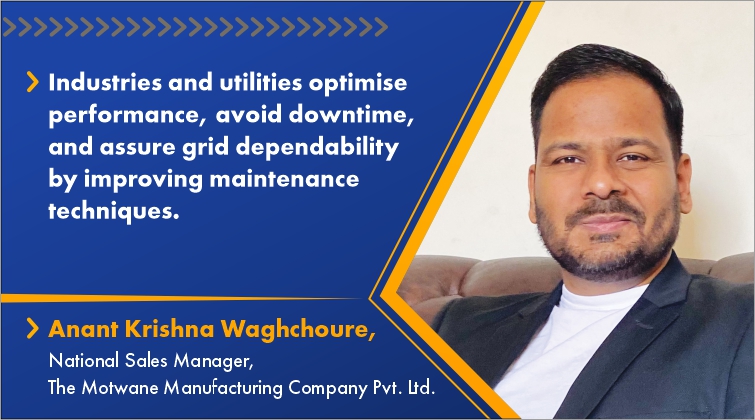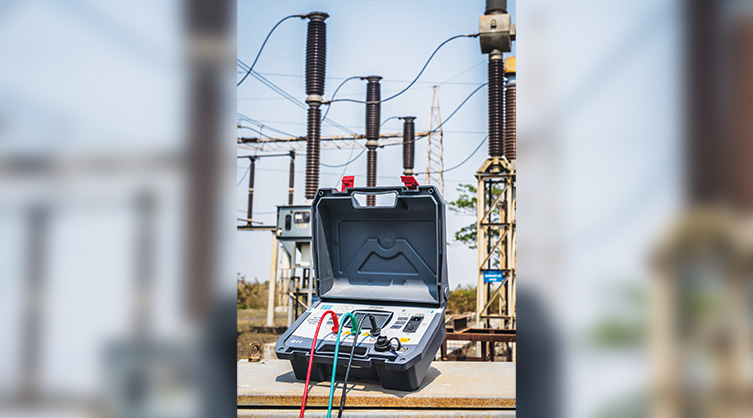Transformers and renewable energy join forces for a sustainable grid
By EPR Magazine Editorial July 24, 2023 1:31 pm IST
By EPR Magazine Editorial July 24, 2023 1:31 pm IST

Transformers efficiently integrate renewable energy into the grid, improving power quality and grid stability for a more sustainable future, explains Anant Krishna Waghchoure, National Sales Manager, The Motwane Manufacturing Company Pvt. Ltd.
What is transformer efficiency in India, and what measures are being taken to improve the impact on energy conservation?
Transformer efficiency is vital in conserving energy, directly impacting electricity loss during transmission and distribution in India. The Bureau of Energy Efficiency (BEE) establishes energy efficiency standards and promotes energy conservation initiatives across various sectors, including the power industry.
While there is no official data regarding the overall transformer efficiency in India, approximate values can be inferred through monitoring solutions. For instance, solar parks demonstrate an impressive efficiency of 98–99 percent, utilities exhibit a range of 90–95 percent, industries boast an efficiency of 97–98 percent, and commercial complexes maintain an efficiency range of 96–98 percent.
Efforts to enhance transformer efficiency in India are a priority for energy conservation. BEE’s Star Rating Program and MEPS promote energy-efficient models and phase out inefficient ones. Initiatives like NMEEE, research collaborations, and renewable energy promotion contribute to ongoing efforts. Smart grid technologies, policies, and incentives also support conservation. For up-to-date information, consult the latest sources and reports.
How does deploying smart transformers in India contribute to enhanced grid management, load balancing, and demand response capabilities?
The potential benefits and challenges associated with scaling up the implementation of smart transformers are as follows: Enhanced Grid Management allows grid operators to proactively identify and address issues, optimising grid operations for improved efficiency. Load Balancing through smart transformers helps prevent overloading, reduces energy losses, and enhances grid reliability. Smart transformers also enable Demand Response capabilities, facilitating two-way communication between operators and consumers for real-time power distribution management, optimising energy consumption, and reducing peak demand to enhance overall grid efficiency.
How can proactive maintenance practices and transformer lifecycle management strategies be employed to optimise their performance and minimise downtime?
Maintenance strategies continuously evolve to prevent downtime and economic losses in systems, with industries and utilities transitioning from reactive to proactive and predictive approaches. Key points include regular visual inspections and checks to detect visible damage, leaks, or abnormalities. Integration of sensors and monitoring devices tracks parameters like temperature, oil quality, moisture levels, and gas analysis. Regular dissolved gas analysis (DGA) tests on transformer oil detect and analyse dissolved gases for early issue detection. Thermal imaging cameras capture temperature profiles, identifying abnormal hotspots. Routine oil sampling and analysis assess the insulating oil condition, reducing insulation breakdown risk.
Transformers are operated within their rated load capacities to prevent overloading, while effective asset management tracks and manages transformer lifecycles, maintaining detailed maintenance records and historical data. Adequate training is provided to maintenance personnel to enhance their knowledge and skills in transformer maintenance and troubleshooting.
Routine maintenance tasks, such as cleaning, tightening connections, checking insulation, and conducting dielectric tests, follow manufacturers’ recommendations and industry standards. Strong collaborations with transformer manufacturers guide maintenance practices, upgrade options, and lifecycle management strategies for specific transformers.
Incorporating these practices helps reduce system downtime, improve efficiency, and avoid economic losses. By adopting proactive and predictive maintenance, industries can optimise performance and ensure reliable and continuous operations.
How are transformers integrated with RE sources to enable efficient power distribution, grid stability, and seamless integration of decentralised energy?
Transformers are crucially integrated with renewable energy (RE) sources to efficiently utilise and integrate them into the grid. Step-up transformers increase voltage for long-distance transmission from renewable power plants, while step-down transformers lower voltage levels for localised distribution of RE-generated electricity. They connect solar farms, wind farms, and other RE installations to the main grid, seamlessly integrating renewable power.
Transformers ensure voltage stabilisation and power quality, essential for handling intermittent RE sources’ fluctuations during decentralised energy integration. They, along with inverters, convert DC power from sources like solar PV systems into AC compatible with the grid, facilitating efficient distribution.
Smart transformers with advanced monitoring, communication, and control capabilities optimise decentralised energy integration, balance supply and demand, and enhance grid stability within smart grid systems. They also play a crucial role in energy storage systems, storing excess energy from intermittent RE sources and ensuring smooth power flow and grid stability during energy discharge.
Combining transformers with power electronics like STATCOM provides reactive power compensation and voltage control, supporting stable grid operation for successful RE source integration. By leveraging these transformer integration methods, renewable energy sources effectively contribute to the overall energy supply while upholding grid stability and reliability.
For more details, visit: https://motwane.com/
We use cookies to personalize your experience. By continuing to visit this website you agree to our Terms & Conditions, Privacy Policy and Cookie Policy.